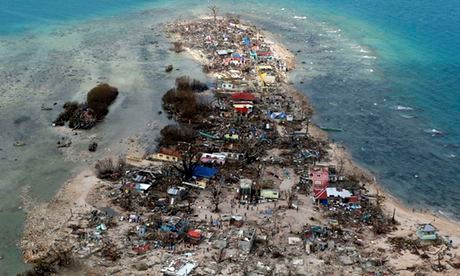But aid agencies say Haiyan is likely to just be the overture. The rising intensity of tropical storms, combined with their increasingly unseasonal timings, means rebuilding may be incomplete when the next super typhoon hits. This would compound the disaster into a catastrophe. Tariq Reibl, Oxfam's humanitarian response manager for the Philippines, says that climate change will mean destructive storms, disastrous enough in isolation, will increasingly occur in procession.
"You're looking at about 20 typhoons per year for the Philippines and as a whole those 20 are going to be more powerful. And then, one or potentially two of those 20 in the future would be a super typhoon … that is something that we didn't see 10 years ago," he says.
Oxfam's Haiyan recovery operation is currently costing £1m every week. And yet, six months after the event, the rebuild is only just beginning. Reibl says small but unseasonal storms have continually diverted resources away from the effort.
Reibl says: "If there is another storm that is even close to Haiyan … there could be higher death tolls, there could be much worse impact because the resilience that existed previously is all down. Everything was destroyed in Haiyan, in terms of evacuation centres, in terms of livelihoods."
The damage Haiyan caused outstripped any storm the typhoon-prone islands had experienced before. Reibl says typhoon Bopha in 2012 had already redefined ideas on how big a typhoon could get, and yet "just a year later, Haiyan made Bopha seem like just a little wind … When Bopha happened we didn't envisage a Haiyan. Can we envisage something more than Haiyan?"
Reibl says that in the past the Philippines were considered the 7-11 of natural disasters – small but open all hours. Indonesia, with its large but infrequent disasters, was more like a mega mall. He says the scale of devastation wrought by Haiyan meant the Philippines had become "a mega mall that is now also open 24/7".
At the Warsaw climate talks, which started just three days after Haiyan hit the coast, the Philippines' UN representative Yeb Sano captured the attention of the world as he pleaded with leaders to attend to the catastrophe in his homeland and act to "prevent a future where super typhoons become a way of life".
But Chris Field, one of the authors of the UN's recent report on the impacts of climate change, says the intensity of storms is already increasing. "We are now in an era where climate change isn't some kind of future hypothetical."
What was really scary about Haiyan, says Paul Jenkins, head of partnership development at the Red Cross, was that it happened in a country that was considered well prepared for this type of disaster. "You can imagine if that kind of event had struck a country with less good logistics, less structures, less government capacity it could have been absolutely catastrophic."
Anthony Spalton, disaster risk reduction specialist at Unicef, says a major part of preparing for extreme weather events is community education. During Haiyan, many people died because they did not know what a storm surge was and stayed with their properties. Unicef has created region-specific curriculums for schools to teach children how to respond in disaster situations.
Jenkins says that, while "mega-events" such as Haiyan receive the majority of interest and resources, the full impact of climate change will be subtler and much greater. "If you look at a global picture, the issue is that [climate change] is already there and it's not necessarily about mega-events, it's about increasing vulnerability due to climate change." He says the "collective impact over a year" of changing seasonality, crop impacts, drought and sea level rise "will vastly exceed the number of people affected by a Haiyan".
Spalton says the effects of climate change will be felt worst in regions prone to floods, droughts or storms. As a result, Unicef has shifted the emphasis of many of its programmes towards preparing for climate-change-related disasters. "While there may not be new funding available, there's a recognition that the funding we do have needs to be orientated differently to these global trends."
Spalton says the scale of the problem is such that existing funding is inadequate for providing protection to vulnerable communities. This will only get worse as the effects of climate change become more pronounced. Jenkins says climate change is now the biggest driver of change in the way aid funding is spent.
Source: The Guardian | 28 April 2014

 In November 2013, typhoon Haiyan delivered destruction to the Philippines and a stark message that the world is underprepared for the violence of climate change.
In November 2013, typhoon Haiyan delivered destruction to the Philippines and a stark message that the world is underprepared for the violence of climate change.











